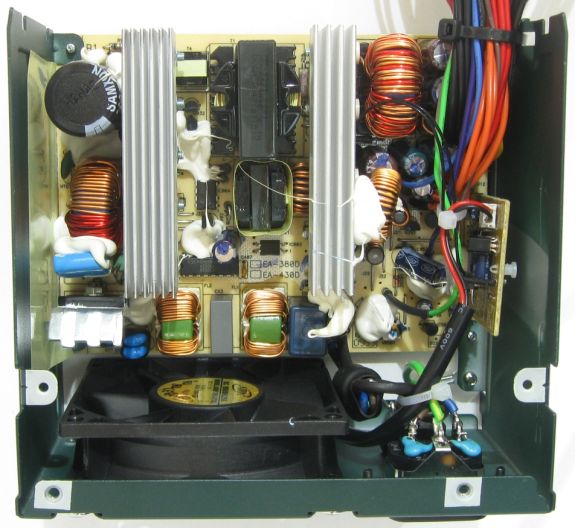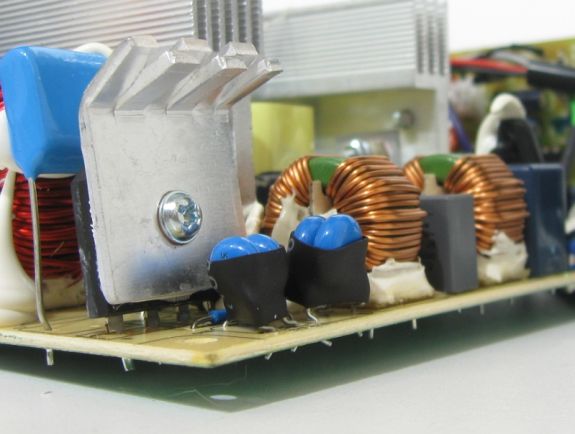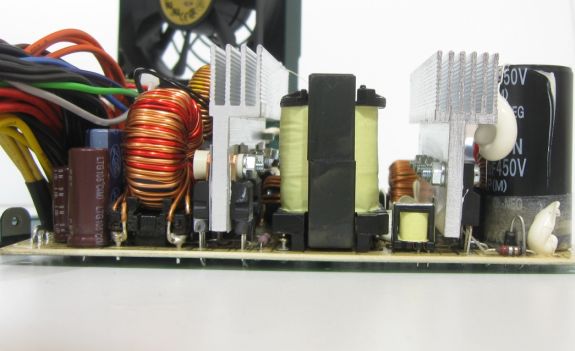Antec EarthWatts EA 380D Green 380W
by Martin Kaffei on October 2, 2010 7:00 PM EST- Posted in
- Cases/Cooling/PSUs
- PSUs
- Green
- Antec
- Earth Watts
- 380W
Internals
After opening the PSU, a well-structured design can be seen with two rather slim heat sinks, which are positioned according to the airflow. Similar to the first EarthWatts models (designed by Seasonic), the heat sinks don’t form a tunnel topology, which means that the airflow isn’t as linear as we have seen elsewhere--i.e. an Arctic Cooling PSU with their thoughtfully positioned air foil. But there is less energy dissipating into heat because of the lower nominal power and higher efficiency and there are large spaces inside where the air is able to circulate. The position of the rectifier bridge with its heatsink and the EMI-filter slightly hinder the airflow.
The IEC-plug is followed by the mains switch, which engages the phase conductor when thrown. Two Y-caps are connected with a protective ground wire, which is securely fixed on the case. Additional glue would be useful to improve mechanical stability. Well-twisted phase and neutral wires are coiled around an additional ferrite core and securely soldered. If wires are not twisted well, the connection could easily break. [Note: The quality in Chinese factories is still fluctuating.]
Two common mode chokes, four Y-caps, and two X-caps follow, with another X-type cap located behind the rectifier bridge; however, a varistor is missing. From this perspective we can see how precisely the chokes are fixed. In the power factor pre-regulator, we find a Samxon capacitor with the model number MXL. The Champion-IC 6800AG regulates the PFC and the main circuit of the PSU. This IC features OCP (Over Current Protection) and short circuit protection and has become popular because of its low-loss controlling.
Since the glue can’t always be positioned accurately, the 12V-choke is stabilised with a socket, which is useful at certain sizes. The costs are higher and the processing is more complicated. This kind of fastening is more likely to be found in high-end models. Sometimes this method is impossible, since the space is limited. The last model with this feature was the Enermax Revolution85+ 850W, where the size of the PFC-choke was the problem. In the OEM sector it is common to fix the components above necessity.
The +12V rail is filtered by Nippon Chemi-Con (KZE) and Ltec (LZG) capacitors, while on the smaller rails a potpourri of Nippon Chemi-Cons, Ltecs, and a single Taicon are used. A metering diode on a heat sink measures the temperature.
The noted build quality continues with a high soldering quality. Most conducting paths are cleanly soldered, but the output cables of the secondary circuit had to be cut so the wires don’t protrude too much under the PCB. Usually the manufacturer should be able to estimate the lengths of the wire when using THT-components. Connections could break if protruding wires are cut off. On the solder points of phase and neutral wires, solder residue can be found because of a very high soldering temperature, but there are no damages visible.














64 Comments
View All Comments
fausto412 - Saturday, October 2, 2010 - link
let me put it this way.it's $45. I've seen their True Power line at 550 Watts on sale for a few bucks more. the features i would get for spending an extra 10 and the extra capacity would just void me wanting to use this.
but i did forget about the HTPC crowd. still waiting to try it but in the USA HTPC won't take off as long as you can't just decrypt cable/fios/direct tv with your tuner card which i hear may be in the works. still waiting for it.
fredgiblet - Sunday, October 3, 2010 - link
Except you'll probably never use that extra capacity, meaning that you'll have lower efficiency for no reason, costing you much more over the life of the PSU.Additionally there's more than just HTPCs, home servers are usually on all the time and they usually lack high-end CPUs and video cards, I plan to build a torrenting machine that will hopefully draw VERY little power as it will only serve to torrent and have websites open when I'm gaming, there are lots of people for whom programming is their life who don't even have (or need) high-end processors. Realistically we're past the point where the advances in speed really help the average computer user, these days a low to mid range dual-core and an SSD are all the upgrades that most people actually benefit from. If I was asked to build a new computer for any of my relatives I can't think of a single one who I would end up building a computer that draws more than 400W, and I myself will probably never have more than one computer that does either (if even that) it's simply not necessary.
Samus - Sunday, October 3, 2010 - link
HTPC not taking off? You've got to be joking. Practically everybody I know has a computer hooked up to their TV, if not just for streaming netflix, it's good for web browsing, youtube, hulu, itunes, etc. Then you have the more savvy users that have 1TB+ video libraries. Windows Media Center was a joke, yes, and using the PC to watch TV is a joke, yes, but those are just about the only TWO things wrong with the HTPC.fausto412 - Sunday, October 3, 2010 - link
for what i want my HTPC to do....we are not there yet. it's not replacing my cable box or my tivo box yet and it can't do video on demand with the cable company. when it handles those 3...i'll get rid of both and build an htpc.martyrant - Sunday, October 3, 2010 - link
First, did you just say HTPCs haven't taken off in the USA? Really, man? Where have you been for like, what, the last 8 years?Second, did you really just say HTPCs haven't taken off in the USA? Alright, alright.
Third, I got it on sale for $25 to replace a dead one in my girlfriend's HTPC/gaming rig (you heard it, HTPC in the USA!).
Her specs (she plays the sims and watches TV on it, she has my old monitor which is pretty nice):
GIGABYTE GA-MA785GMT-UD2H
AMD Athlon II X3 435 (unlocked to 4 fine)
OCZ AMD Black Edition 4GB
MSI R4850-512M Radeon HD 4850 512MB
2xWD 640GB
Lite-On DVD/CD combo
fausto412 - Sunday, October 3, 2010 - link
is that htpc able to do everything the cable box does right now? tivo?i've looked into it and i have a more hassle free experience with my tivo and my cable box as the technology stands in the USA.
until htpc's can do video on demand and decrypt video without going thru hoops they won't take over, maybe you and your 3 to 5 geek buddies have htpc's but i don't know anyone. guess i need more geek friends.
AstroGuardian - Sunday, October 3, 2010 - link
You are so boring dude... Come on!Iketh - Saturday, October 2, 2010 - link
i was dying for a small P/S review because I'm about to build my first HTPC. This came right on time, thanks a bunch!crucibelle - Sunday, October 3, 2010 - link
I could use one of these, no problem.jensend - Sunday, October 3, 2010 - link
A top-of-the-line i7 rig with a Geforce 460 or a Radeon 5850 fits comfortably in a 380W envelope. I'm guessing the reason you don't know that is because you "won't even read" Anandtech's actual power consumption tests. The only people who actually need more than this are people with SLI/Crossfire rigs or GF 470/480 cards. And they make up only a tiny fraction of the people reading Anandtech. Many people aren't even gamers, in which case a 200W PSU would be plenty with modern CPUs.